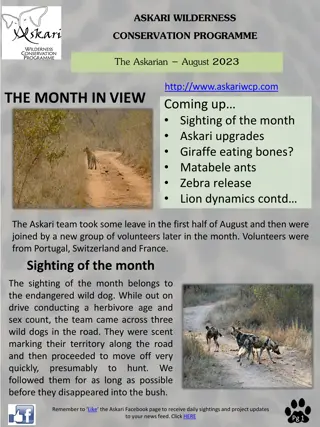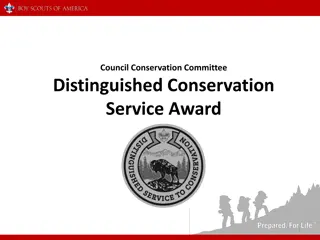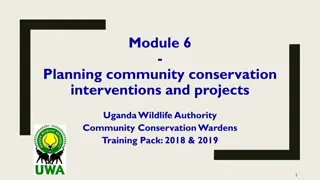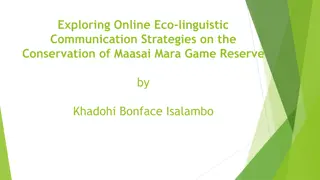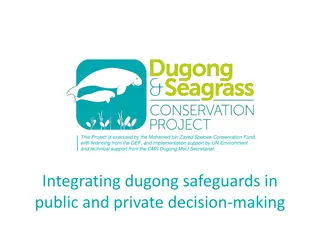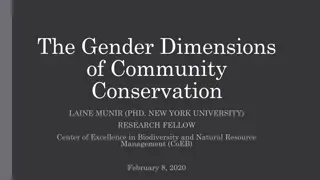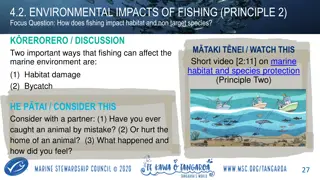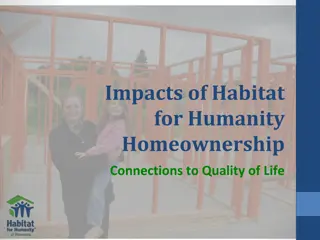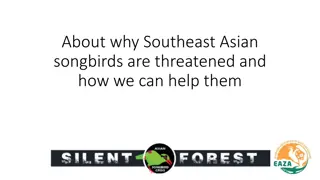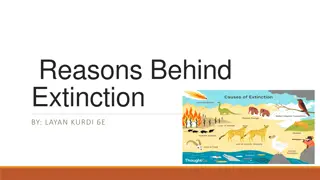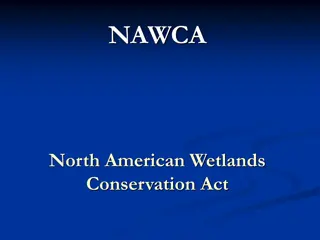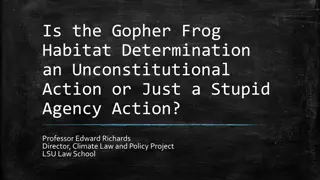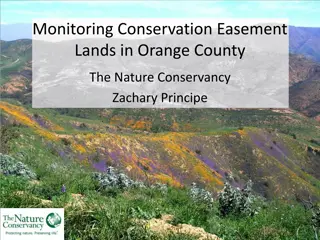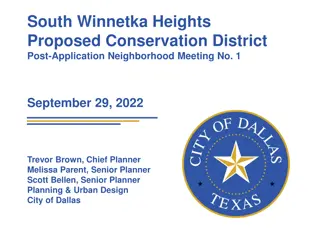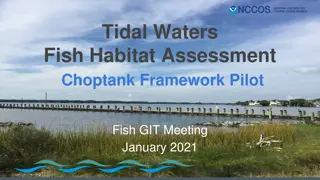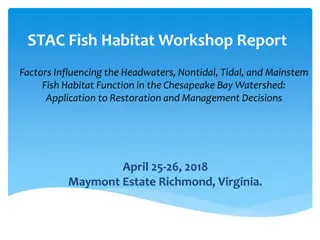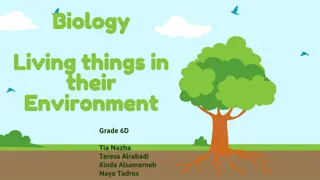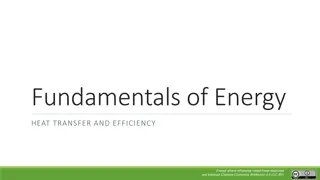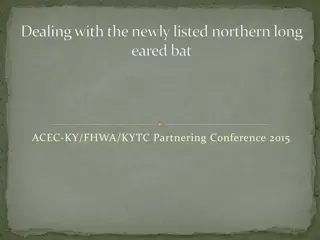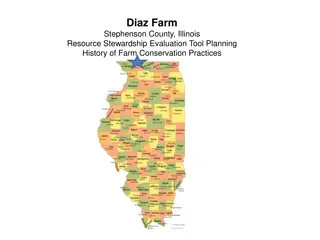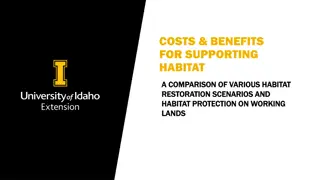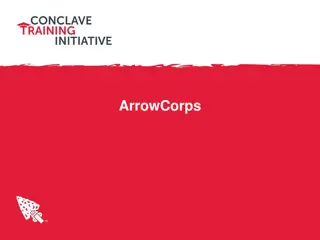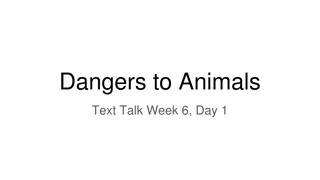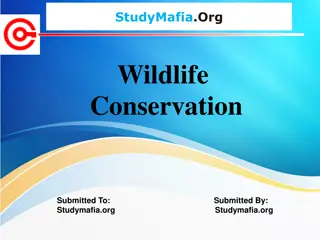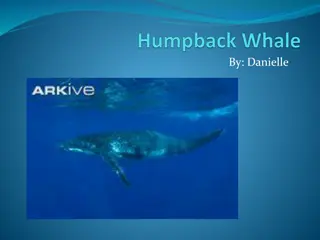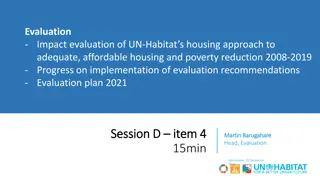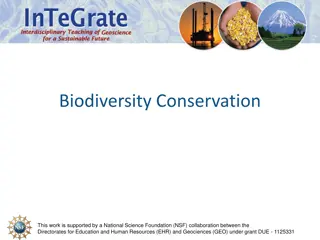NRCS Programs Update
The Inflation Reduction Act (IRA) provides $20 billion to support USDA's conservation programs focusing on climate-related benefits and agricultural resilience. It allocates funds for programs like the Environmental Quality Incentives Program, Agricultural Conservation Easement Program, Regional Con
2 views • 14 slides
Askari Wilderness Conservation Programme August 2023 Newsletter
The Askari Wilderness Conservation Programme's August 2023 newsletter highlights the team's encounters with endangered wild dogs, upgrades to the conservation area including the building of a waterhole, unique wildlife sightings like a giraffe eating bones, and observations of Matabele ants. Volunte
1 views • 5 slides
Effective Methods for Soil Conservation
Methods to reduce soil erosion and promote soil conservation include terracing, contour planting, strip cropping with cover crops, alley cropping, agroforestry, windbreaks, and conservation tillage practices such as no-till and minimum tillage. These methods help in minimizing soil erosion hotspots
1 views • 11 slides
Designing a Sustainable Mars Habitat for Long-term Crew Stay
Design a Mars habitat for the first human crew that will be staying on Mars for several years. The habitat must include essential components such as sleeping quarters, restroom, exercise room, radiation shielding, food/water supply, entertainment, and ISRU technologies. Teams will research, create a
0 views • 7 slides
Council Conservation Committee Distinguished Conservation Service Award
The Council Conservation Committee Distinguished Conservation Service Award is a prestigious recognition in scouting, involving projects, workbook completion, and assessment by a Council Board of Review. Councils must establish their own policies for administering the award. Scouts recognized with a
1 views • 20 slides
Understanding Conservation Project Planning Basics
This module explores basic terminology in conservation project planning, focusing on key concepts like project, intervention, and community project. It delves into understanding the steps involved in planning for conservation projects, with a special emphasis on terminology and definitions essential
0 views • 44 slides
Strategies for Online Eco-Linguistic Communication in Maasai Mara Conservation
Maasai Mara faces threats from human encroachment, prompting conservation efforts. This study explores online eco-linguistic strategies for engaging the public in conservation activities. The importance of language in online communication to achieve ecological harmony is highlighted, emphasizing eco
0 views • 17 slides
Marine Conservation Governance in Raja Ampat, West Papua, Indonesia
Explore the dynamics of marine conservation governance in Raja Ampat, West Papua, Indonesia, with a focus on Sasi practices and the preliminary findings in the West Misool and South Misool districts. Discover the potential resources in Raja Ampat and the various types of marine conservation areas in
0 views • 22 slides
Conservation Efforts for Dugongs and Seagrass in Vanuatu
The Mohamed bin Zayed Species Conservation Fund, with support from the GEF and UN Environment, is implementing a project in Vanuatu to address knowledge gaps, raise awareness, and develop a National Plan of Action for the conservation of dugongs and their seagrass habitat. Through identifying and pr
0 views • 14 slides
Exploring Gender Dynamics in Community Conservation
This research delves into the intricate relationship between gender and conservation efforts, emphasizing the impact of gender roles on biodiversity loss. It discusses gender essentialism, global gender perspectives in conservation, and presents case studies on Payment for Ecological Services (PES)
1 views • 11 slides
Environmental Impacts of Fishing: Habitat Damage and Bycatch
Fishing can negatively impact the marine environment through habitat damage and bycatch. Habitat damage occurs when fishing gear harms delicate seafloor habitats where endangered species grow. Bycatch, or unwanted catch, involves unintentionally capturing marine species like whales, dolphins, and se
0 views • 4 slides
Impact of Habitat for Humanity Homeownership on Quality of Life
A study by Wilder Research on Habitat for Humanity homeowners in Minnesota reveals positive impacts on safety, health, education, social connectedness, family interaction, personal well-being, and economic situation. Results show improved quality of life, with high levels of satisfaction and safety
0 views • 13 slides
Protecting Southeast Asian Songbirds: Conservation Efforts and Challenges
Southeast Asian songbirds face threats such as habitat loss, illegal capture for the pet trade, and hunting. Conservation efforts are vital to protect these species from further decline. Awareness, enforcement of laws, and habitat restoration can help save these beautiful birds from extinction.
0 views • 32 slides
Challenges and Solutions in Harbor Herons Citizen Science Surveys
The Citizen Science Surveys regarding harbor herons face various challenges such as habitat assessments, effects of tides, distance issues, and discrepancies in data entry. Volunteer input, carefully crafted protocols, and maintaining contact with volunteers help in addressing these challenges. Solu
0 views • 29 slides
Threats to Wildlife Conservation: Understanding Extinction Causes
Animals face extinction due to genetic factors, habitat destruction, invasive species, global warming, hunting, and illegal trade. Black rhinos are critically endangered mainly due to poaching and habitat loss. Tree kangaroos and rockhopper penguins are also at risk due to habitat degradation and cl
0 views • 6 slides
North American Wetlands Conservation Act (NAWCA) Overview
The North American Wetlands Conservation Act (NAWCA) is a federal funding program established to protect and restore wetlands in North America. Through Joint Ventures, partners access funds for various projects across the region, with grants available for both standard and small projects. The act re
0 views • 15 slides
Legal Analysis of Gopher Frog Habitat Determination
Professor Edward Richards from LSU Law School discusses the potential constitutional issues raised by the designation of critical habitat for the gopher frog. The analysis includes examining interstate commerce issues, regulatory takings, wetlands permitting under the CWA, and the proper designation
0 views • 11 slides
Overview of 2014 Federal Farm Bill Provisions
The 2014 Federal Farm Bill introduced various amendments impacting conservation compliance, pollinator protection, the Conservation Reserve Program (CRP), and easement programs. Changes included recoupling federal crop insurance benefits to conservation requirements, extending pollinator protection
0 views • 25 slides
Conservation Easements and Monitoring in Orange County by The Nature Conservancy
The Nature Conservancy plays a vital role in monitoring and managing conservation easement lands in Orange County, ensuring the protection of conservation values and natural resources. Through the Irvine Ranch Conservation Easements, they uphold specific permitted and prohibited activities while tai
0 views • 19 slides
Arctic Habitat and Polar Bears: A Conservation Perspective
The Arctic habitat, home to diverse plants and animals like polar bears, faces threats such as climate change, toxic pollution, and oil exploration. Despite past population growth, polar bear numbers are now estimated to be between 22,000 to 31,000. Conservation efforts by Scandinavian countries hav
1 views • 6 slides
South Winnetka Heights Proposed Conservation District Post-Application Neighborhood Meeting
This document provides details about the post-application neighborhood meeting for the proposed conservation district in South Winnetka Heights, Dallas. The meeting aims to discuss development standards and architectural considerations chosen by the neighborhood, including driveways, curbing, front
1 views • 37 slides
Tidal Waters Fish Habitat Assessment Choptank Framework Pilot Fish GIT Meeting January 2021
The Tidal Waters Fish Habitat Assessment Choptank Framework Pilot Fish GIT Meeting held in January 2021 discussed background, drivers, and the selection of the Choptank River as a candidate tributary. The project team, responsible parties, actions, and timeline for developing an analytical framework
0 views • 17 slides
Factors Influencing Fish Habitat in Chesapeake Bay Watershed Workshop Report
This workshop report delves into the factors affecting fish habitat function in the Chesapeake Bay Watershed, focusing on headwaters, nontidal, tidal, and mainstem areas. It outlines the workshop process, assessment frameworks, and user needs to support restoration and management decisions. The repo
1 views • 31 slides
The Fascinating Malayan Tapir: Habitat, Range, and Adaptations
The Malayan tapir, the largest of its kind, is uniquely adapted to its habitat in tropical lowland swamps, montane and hill forests. With its distinctive black and white color pattern for camouflage and a prehensile snout for feeding and communication, this species thrives in Myanmar, Thailand, Mala
0 views • 26 slides
Understanding Energy Efficiency and Conservation Fundamentals
This unit introduces basic terms related to energy, efficiency, and conservation, covering topics such as Efficiency and Conservation Energy, First and Second Law of Thermodynamics, and various heat transfer mechanisms. It emphasizes responsible energy use, focusing on efficiency, conservation, and
0 views • 14 slides
Exploring the Northern Long-Eared Bat: Habitat, Range, and Conservation Status
Discover the fascinating world of the northern long-eared bat (NLEB) through insights on its range, appearance, habitat preferences, and conservation status. Learn about its roosting habits, distribution across states, and the challenges it faces as a threatened species. Delve into the complexities
0 views • 25 slides
Threats to Biodiversity: Habitat Loss and Conservation Efforts
Habitat loss is a significant threat to species worldwide, with forests, swamps, plains, and other habitats disappearing due to human activities. The decline of black rhinos and the conservation efforts made to protect them illustrate the impact of such activities on wildlife populations. African Pa
2 views • 12 slides
Diaz Farm Conservation Journey in Illinois
Explore the 17-year conservation journey of Diaz Farm in Stephenson County, Illinois, led by Dan Diaz, focusing on sustainable land management practices and the use of Resource Stewardship Evaluation Tool for conservation planning. The farm's history, conservation engagement with various organizatio
0 views • 9 slides
Understanding Algae: Classification, Habitat, and Reproduction
Algae are chlorophyllous thallophytes that thrive in aquatic environments, producing their own food and oxygen through photosynthesis. They are categorized based on habitat as aquatic, terrestrial, aerophytes, cryophytes, and thermophytes. The three main classifications of algae are Chlorophyceae (g
0 views • 16 slides
Habitat Restoration and Protection Initiatives in SW Washington: Costs and Benefits
Restoration and protection efforts for various habitat scenarios, including non-working land restoration and working land habitat protection in Southwest Washington. The activities for prairie restoration on Scotch Broom infested land are detailed, along with costs associated with restoring prairie
0 views • 24 slides
Understanding Conservation and Taking Action
Explore the purpose of conservation and learn how to plan and execute conservation projects using local, regional, and national resources. Discover the legacy of the ArrowCorps service project and understand the difference between conservation and preservation. Identify conservation issues and resou
0 views • 12 slides
Understanding Dangers to Animals: Predators and Habitat Loss
Animals face various dangers in their natural habitats, including predators and habitat loss. Predators like owls, bobcats, and racoons hunt other animals, while habitat loss, such as the melting Arctic ice cap, threatens species like polar bears. Human activities, like beach development, also impac
0 views • 19 slides
Wildlife Conservation: Protecting Species and Habitats for a Sustainable Future
Wildlife conservation is essential to safeguarding the diverse species and habitats on our planet. Threats such as habitat destruction, deforestation, and overexploitation endanger wildlife populations globally. Through conservation methods and raising awareness, we can work towards restoring and pr
0 views • 23 slides
Conservation Challenges and Opportunities in the 2018 Farm Bill
The 2018 Farm Bill presents a battleground where conservation, environmental protection, and agricultural interests collide. Key issues include changes in the Clean Water Act, pesticide use, CAFO operations, NEPA requirements, and potential impacts on conservation programs like the Conservation Stew
0 views • 7 slides
Fascinating Facts About Humpback Whales - A Conservation Story
Humpback whales, with their distinctive features and behaviors, are fascinating creatures residing in oceans worldwide. They face endangerment due to factors like hunting, entanglement in fishing gear, and habitat degradation. Fortunately, conservation efforts have led to promising signs of recovery
1 views • 14 slides
Elk Creek Wood Replacement Project Overview
This project, led by the Oregon Watershed Enhancement Board in 2009 and documented by Katie Halvorson, focuses on the replacement of wood structures in Elk Creek to enhance watershed function and habitat complexity for juvenile coho salmon. By addressing the lack of large wood, the initiative aims t
0 views • 20 slides
Inspiring Faith and Service: Habitat for Humanity's Christian Mission
Explore the journey of Habitat for Humanity, a global Christian organization dedicated to putting love into action by building homes, communities, and hope. Through faith, humility, and a commitment to serving others, Habitat demonstrates the teachings of Jesus and invites individuals of all backgro
0 views • 12 slides
Conservation Efforts for Wildlife in Georgia
The Coastal Nongame Conservation Section of the Wildlife Resources Division at the Georgia Department of Natural Resources is dedicated to conserving nongame wildlife through species recovery plans, research, surveys, and habitat management. They focus on managing recovery programs, acquiring land,
0 views • 43 slides
Impact Evaluation of UN-Habitat's Housing Approach 2008-2019
The Impact Evaluation of UN-Habitat's Housing Approach assessed the impact of UN-Habitat's efforts in providing adequate, affordable housing, and reducing urban poverty between 2008-2019. The evaluation included regional and country reports, focusing on the effects and impacts of UN-Habitat's Housin
0 views • 14 slides
Understanding Biodiversity Conservation and Its Importance
Exploring the concept of biodiversity conservation supported by the National Science Foundation, this work delves into the impacts of human activities on biological diversity, compares current extinction rates with past events, evaluates species conservation priorities, and distinguishes between ex
0 views • 16 slides

